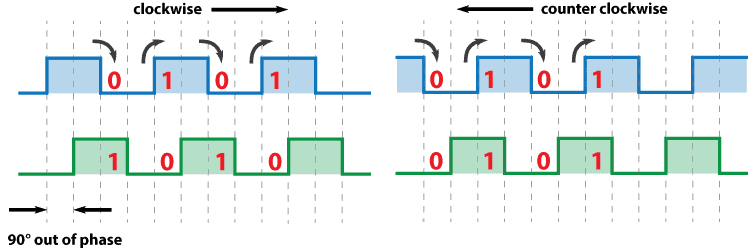What is Rotary Encoder?
A rotary encoder is an electro-mechanical device that converts the rotational position or movement of a shaft into an analog or digital signal. It is commonly used to measure the angular position, speed, and direction of a rotating object. Rotary encoders are essential in many industries, including robotics, automotive, industrial machinery, consumer electronics, and aerospace, where precise control of movement or positioning is required.

Types of Rotary Encoders
- Absolute Encoder
- These encoders provide a unique position value for each angle of the shaft. Even if power is lost, they remember their position and provide the exact location when powered back on. This feature is valuable in applications where knowing the exact position is critical, even after a system restart.
- Incremental Encoder
- These encoders only provide information about changes in position, meaning they measure the number of steps or increments the shaft has rotated. They are often used in applications where only the relative movement is needed. When the power is turned off, they lose their positional reference and need to be reset.
The output of an absolute encoder shows the shaft position, making it an angle transducer. The output of an incremental encoder provides information about the shaft’s motion, which is usually processed elsewhere into information like position, speed, and distance.
How Rotary Encoder Works?
Rotary encoders work by detecting the movement of a rotating disk or shaft. The encoder has a disk with patterns (either optical or magnetic) and a sensor that reads these patterns as the shaft turns. Based on the signal received, the encoder can determine the angle, speed, and direction of the rotation.
Magnetic Encoders: Use a magnetic sensor to detect changes in the magnetic field created by the rotating disk or magnetized shaft. Magnetic encoders are often more robust and better suited for harsh environments than optical encoders.
Optical Encoders: Use a light source and a photodetector to read patterns on a disk. As the disk rotates, the light is interrupted, creating a digital pulse that indicates movement.

When the disk will start rotating step by step, pins A and B will start contacting the common pin and thus the two square wave output signals are going to be generated respectively.
Any of the two outputs are going to be used for determining the rotated position if we just count the pulses of the signal. However, if we would like to demonstrate the rotation direction as well, we’d like to consider both signals at identical times.
We can recognize that it displaced the 2 output signals at 90 degrees out of phase from each other. If the encoder is rotating clockwise the output, A will be prior to output B.

So if we count the steps every time the signal changes, from High to Low or from Low to High, we will notice at that point the two output signals have opposite values. Vice versa, if the encoder is rotating counter-clockwise, the output signals have equal values. So looking at this, we can easily program our controller to read the encoder position and the rotation direction.
What is LED Rotary Encoder?
An LED rotary encoder is a type of rotary encoder that uses LED light to detect the rotation, position, or speed of a shaft or knob. This encoder combines traditional rotary encoder technology with LED illumination to provide visual feedback, making it useful in applications where both rotational control and visual cues are important.

Advantages of LED Rotary Encoders
- Visual Feedback: The LED lighting helps users quickly understand the position or status of the encoder, which is ideal for control panels or applications where visual indicators are valuable.
- Customization: Many LED rotary encoders allow for RGB color changes, which can be customized to suit different functions, status indicators, or even brand aesthetics.
- Durability: With few moving parts and solid-state LEDs, these encoders are typically durable, reliable, and suited for high-frequency applications.
Applications of LED Rotary Encoders
- Audio Equipment: Mixing consoles, audio interfaces, and DJ equipment, where users need precise control over levels and settings.
- Control Panels: In industries like broadcasting, automation, and aviation, where LED feedback can indicate different operational modes or levels.
- Gaming: In controllers or game consoles, providing tactile and visual feedback to enhance user experience.
- Medical Devices: To allow intuitive, controlled adjustments with visual confirmation in medical settings.
Compared to the Rotary Encoder, the LED Rotary Encoder provides the user with clear visual feedback, which greatly improves operational accuracy and enhances the visual appearance of the product.
In order to meet the further demand for LEDs we have added the Addressable RGB LED solution.

These LEDs have an IC built right into the LED. This allows a communication via a one-wire interface. This means that you can control lots of LEDs using just one digital pin of your Arduino.
For more information on addressable LEDs, you can click here.
If you would like to try Rotary Encoder with addressable LEDs on your project feel free to contact us or leave a comment below the article.



